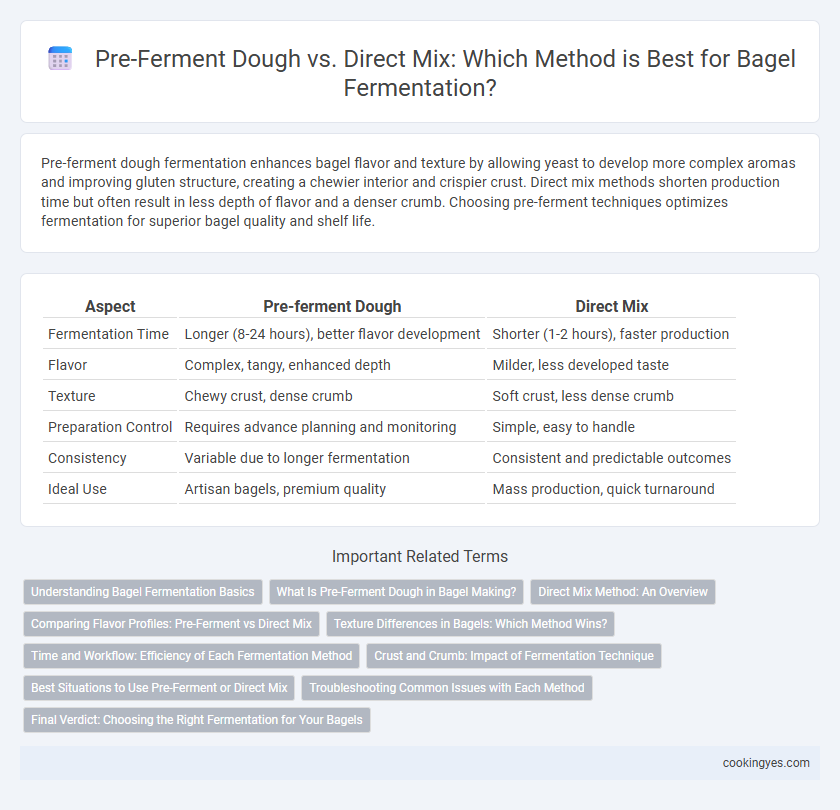Pre-ferment dough fermentation enhances bagel flavor and texture by allowing yeast to develop more complex aromas and improving gluten structure, creating a chewier interior and crispier crust. Direct mix methods shorten production time but often result in less depth of flavor and a denser crumb. Choosing pre-ferment techniques optimizes fermentation for superior bagel quality and shelf life.
Table of Comparison
| Aspect | Pre-ferment Dough | Direct Mix |
|---|---|---|
| Fermentation Time | Longer (8-24 hours), better flavor development | Shorter (1-2 hours), faster production |
| Flavor | Complex, tangy, enhanced depth | Milder, less developed taste |
| Texture | Chewy crust, dense crumb | Soft crust, less dense crumb |
| Preparation Control | Requires advance planning and monitoring | Simple, easy to handle |
| Consistency | Variable due to longer fermentation | Consistent and predictable outcomes |
| Ideal Use | Artisan bagels, premium quality | Mass production, quick turnaround |
Understanding Bagel Fermentation Basics
Pre-ferment dough involves fermenting a portion of the dough ingredients separately before mixing them with the remaining ingredients, enhancing flavor complexity and improving crust texture in bagels. Direct mix method combines all ingredients at once, resulting in faster fermentation but often less depth in taste and chewiness. Understanding these fermentation techniques helps bakers control flavor development and texture, crucial for authentic bagel production.
What Is Pre-Ferment Dough in Bagel Making?
Pre-ferment dough in bagel making refers to a partially fermented mixture of flour, water, yeast, and sometimes salt, prepared ahead of the final dough. This technique enhances flavor development, improves dough strength, and promotes better fermentation control compared to the direct mix method, where all ingredients are combined at once. Using pre-ferment dough results in bagels with a more complex taste, chewier texture, and improved shelf life.
Direct Mix Method: An Overview
The direct mix method for bagel fermentation involves combining all ingredients at once without an initial proofing phase, resulting in a shorter production time compared to pre-ferment dough techniques. This method relies on rapid yeast activity, producing a bagel with a chewier texture and slightly less complex flavor profile. Direct mix is favored in commercial settings for its efficiency and consistent product quality.
Comparing Flavor Profiles: Pre-Ferment vs Direct Mix
Pre-ferment dough for bagels develops complex, tangy flavors and a chewier texture due to extended fermentation and organic acid production by wild yeasts and bacteria. Direct mix methods yield a milder, less complex taste with a softer crumb since fermentation occurs only during final proofing, limiting flavor development. Bakers seeking robust, traditional bagel taste often prefer pre-fermentation to enhance depth and aroma compared to quick, convenient direct mixing.
Texture Differences in Bagels: Which Method Wins?
Pre-ferment dough enhances bagel texture by developing stronger gluten strands and deeper flavor complexity through extended fermentation, resulting in a chewier interior and a denser crumb. Direct mix fermentation produces bagels with a lighter, less chewy texture but faster turnover, as it skips prolonged fermentation and relies on instant yeast activity. Texture enthusiasts often favor pre-ferment dough for its traditional, satisfying chew and improved crust characteristics in bagel baking.
Time and Workflow: Efficiency of Each Fermentation Method
Pre-ferment dough fermentation extends total production time but enhances flavor complexity and dough strength, allowing for longer fermentation periods that improve gluten development. Direct mix shortens overall process time by combining all ingredients at once, enabling faster turnaround and simpler workflow suitable for high-demand production. Selecting between pre-ferment and direct mix methods impacts bakery efficiency, balancing flavor depth against operational speed and scheduling flexibility.
Crust and Crumb: Impact of Fermentation Technique
Pre-ferment dough in bagel making enhances crust development by promoting Maillard reactions, resulting in a richer color and crunchier texture compared to direct mix methods. The prolonged fermentation in pre-ferment dough also improves crumb structure, producing a chewier and more aerated interior. Direct mix techniques tend to yield a denser crumb and lighter crust due to shorter fermentation times and reduced enzymatic activity.
Best Situations to Use Pre-Ferment or Direct Mix
Pre-ferment dough is best used for bagels when aiming for enhanced flavor complexity, improved texture, and better fermentation control, making it ideal for artisanal or specialty bagels. Direct mix is suitable for high-volume production or when time constraints demand faster processing, as it simplifies the fermentation process and reduces overall preparation time. Choosing between pre-ferment and direct mix depends on balancing flavor development needs against operational efficiency and production scale.
Troubleshooting Common Issues with Each Method
Pre-ferment dough in bagel fermentation often results in enhanced flavor and texture but requires precise timing and temperature control to avoid over-fermentation or sourness. Direct mix methods simplify the process but can lead to denser bagels with less depth of flavor if the yeast activity is insufficient or inconsistent. Troubleshooting common issues involves monitoring fermentation time closely in pre-ferment dough and adjusting proofing conditions and yeast quantity in direct mix to achieve optimal dough rise and bagel quality.
Final Verdict: Choosing the Right Fermentation for Your Bagels
Pre-ferment dough enhances bagel flavor and texture by allowing yeast to fully develop, resulting in a chewier crumb and more complex aroma compared to direct mix methods. Direct mix is faster and more convenient, ideal for high-volume production but can yield less depth in taste and slightly denser bagels. Ultimately, bakers seeking artisanal quality prioritize pre-fermentation, while those prioritizing efficiency may choose direct mixing based on time constraints.
Pre-ferment dough vs direct mix for bagel fermentation Infographic

 cookingyes.com
cookingyes.com